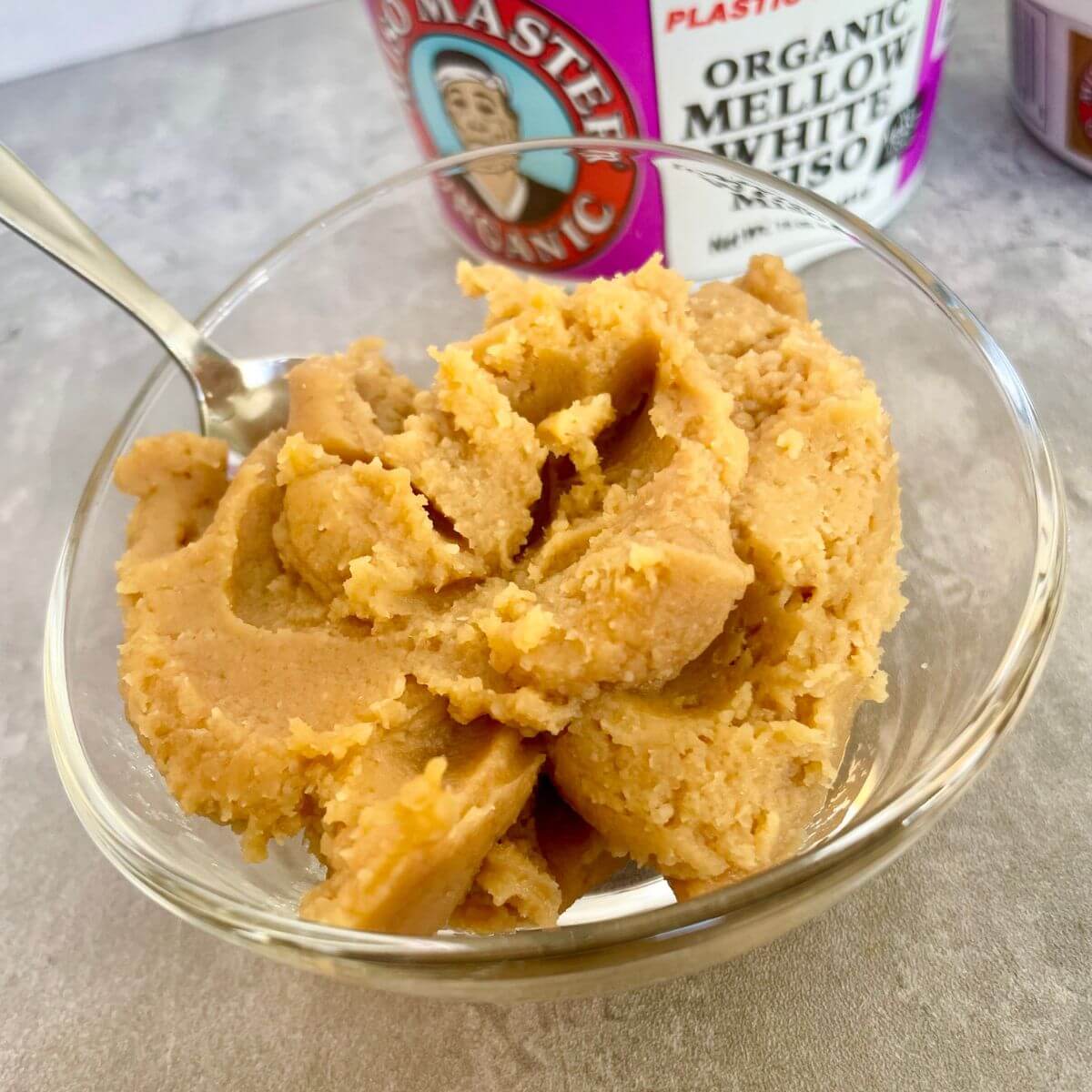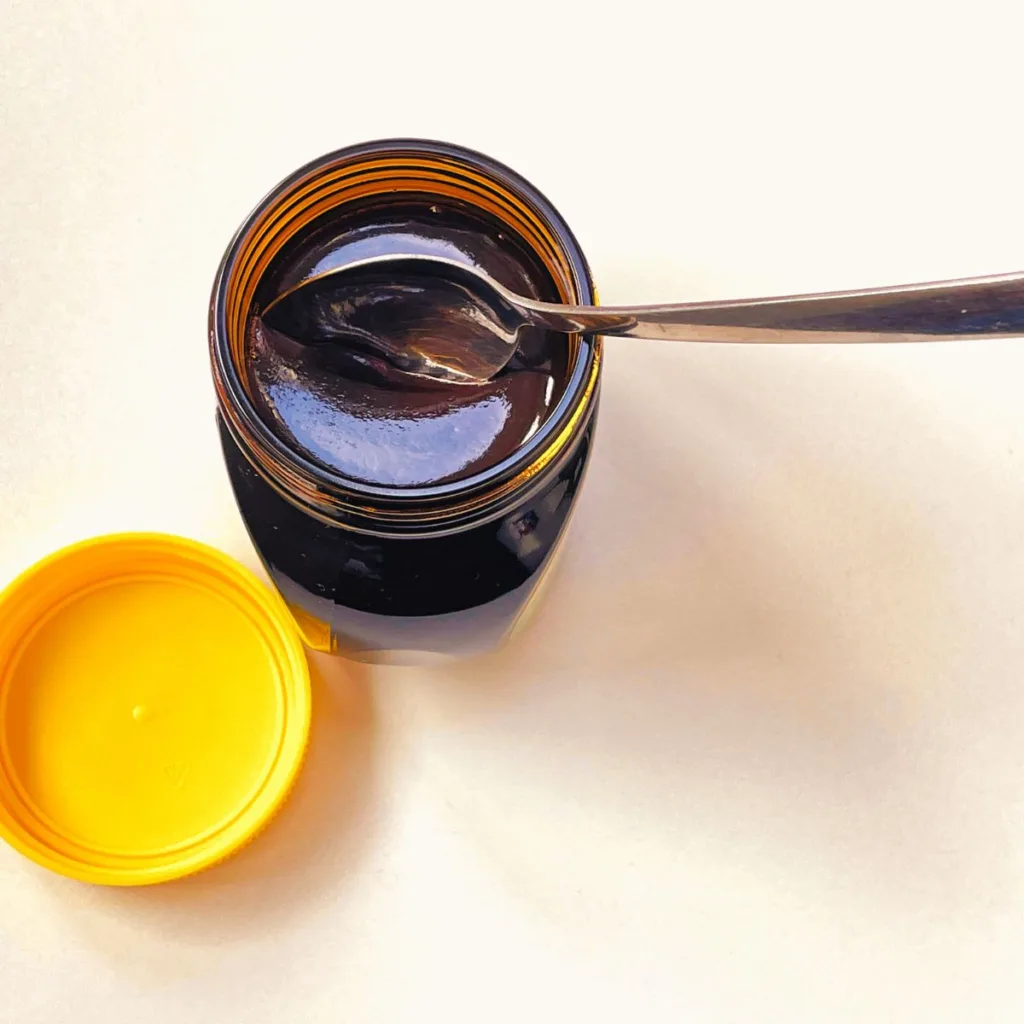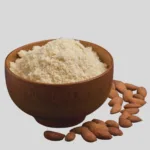Searching for the perfect miso paste substitute can feel like a culinary quest. From savory stews to delicate sauces, miso paste holds a revered place in a multitude of dishes. It can easily take a bland dish to a “wow!” level of deliciousness.
While nothing can precisely replicate its complexity, there are several miso substitutes that can take the place of miso paste without sacrificing too much flavor. Whether you’re in a pinch or looking for a more accessible miso replacement, our guide will walk you through the best alternatives to give your cooking that much-needed depth and richness.
But first, let’s cover a few key things…
What is Miso Paste?
Miso paste is a common ingredient in Japanese cooking. It’s made by fermenting soybeans with salt and koji (Aspergillus oryzae), and often added in with additional grains like rice or barley.
This savory paste is a flavor powerhouse, brimming with umami notes. While it’s best known for being used in miso soup, it’s incredibly versatile. You can use it for marinades, dressings, and even some desserts. The beauty of miso paste lies in its intensity — a small amount goes a long way in elevating the savory and umami flavors in a recipe.
We’ll cover this more below, but there are a few different types of miso paste, such as white, red, and mixed miso. But at the end of the day, this versatile ingredient has a rich, complex profile that can be somewhat challenging to replace, making it crucial to understand suitable substitutes when you’re in a kitchen bind.
Different Types of Miso
Understanding the variety of miso types can help you make an informed choice when seeking the perfect savory flavor profile for your dish. Here are some commonly used types of miso paste:
White Miso Paste (Shiro Miso):
White miso is often described as sweet or mellow miso, undergoes a shorter fermentation process, and contains less salt compared to its darker counterparts. This results in a gentler, more nuanced taste that is highly versatile. Ideal for summery soups, vinaigrettes, and light gravies, it can also serve as a dairy substitute in certain dishes, such as miso-infused mashed potatoes.
Red Miso Paste:
Also known as “Aka Miso,” this type is made from soybeans fermented with barley or other grains, with a higher percentage of soybeans and a much longer fermentation period. Sometimes it’s fermented for years. This results in a deeper, more intense umami flavor that’s well-suited for hearty meat stews and marinades.
Yellow Miso Paste:
Also known as “Shinshu Miso,” Yellow Miso falls in between white and red in terms of flavor intensity and complexity. Made from soybeans and barley, it has a somewhat earthy, salty taste. It’s quite versatile and can be used in a variety of dishes, including soups and glazes.
Miso Paste Substitutes
Now let’s get to the meat of what you’re looking for: the perfect miso paste substitute.
Fish Sauce
Fish sauce is a liquid condiment made from fish that have been salted and fermented. It is commonly used in Southeast Asian cuisines and is renowned for its umami-rich and salty flavors, which can add depth to a wide range of dishes. Personally, it is one of my favorite ingredients.
Best Recipes to Use as a Substitute:
Fish sauce can be used as a substitute for miso in recipes like stir-fries, soups, and marinades.
Substitution Ratio:
Use 1/2 tablespoon of fish sauce to replace 1 tablespoon of miso, adjusting to taste.
Tamari
If you’re a gluten-free gal like me, you’re probably already familiar with tamari. If you’re not, it’s a common gluten-free soy sauce substitute. But Tamari is generally thicker and less salty than traditional soy sauce since it’s fermented for longer. It’s rich in umami flavors and is often used as a dipping sauce or in marinades.
Best Recipes to Use as a Substitute:
Stir fries, marinades, and soups.
Substitution Ratio:
For every tablespoon of miso paste, use one tablespoon of tamari.
Marmite
Marmite is a spread made from yeast extract, a by-product of beer brewing. It’s intensely savory and has a distinct, concentrated umami flavor. Due to its high salt content, it should be used cautiously. It’s not commonly found in the United States but is huge across the pond.
Best Recipes to Use as a Substitute:
Soups, stews, and gravies where a concentrated hit of umami is desired.
Substitution Ratio:
For every tablespoon of miso paste, use a teaspoon of Marmite, considering its intense flavor and salt content.
Anchovy Paste
Anchovy paste is made from ground anchovies and is intensely flavored. It’s rich in umami and often used in Mediterranean and Italian cooking, particularly in pasta sauces and dressings.
Best Recipes to Use as a Substitute:
Pasta sauces, Caesar dressings, and other recipes where a fishy, umami flavor would be complementary.
Substitution Ratio:
For every tablespoon of miso paste, use a teaspoon of anchovy paste due to its strong flavor.
If you’ve never worked with this ingredient, it might sound intimidating. Don’t be. Try this brand of anchovy paste. It’s my go-to fave.
NOTE: Since the main ingredient in anchovy paste is obviously fish, this option is neither vegetarian nor vegan-friendly.
Umeboshi Paste
Umeboshi paste is a pickled plum paste that embodies a sour, salty, and slightly fruity flavor profile. Hailing from Japan, it’s used to add a complex tanginess to a variety of dishes like sushi rice, marinades, and even as a condiment.
Best Recipes to Use as a Substitute:
For replacing miso paste, umeboshi works well in recipes that call for a salty, tangy kick. Think along the lines of dressings, sauces, and some stews.
Substitution Ratio:
Use 1 teaspoon of umeboshi paste for every 1 tablespoon of miso paste. Due to its stronger flavor, it’s advisable to start with less and adjust according to taste.
Doenjang Or Soybean Paste
Doenjang is a Korean fermented soybean paste with a robust, earthy, and slightly spicy flavor. Often employed in Korean cuisine, it serves as the base for a number of traditional dishes like Doenjang Jjigae (Korean soybean paste stew).
Best Recipes to Use as a Substitute:
It works particularly well in recipes that require a deep, umami flavor. Ideal for stews, marinades, and soups, it serves as a close approximation to miso.
Substitution Ratio:
For miso paste substitution, use Doenjang in a 1:1 ratio. Both have a similar texture and flavor intensity, making it easy to swap them without significant adjustments.
Soy Sauce
Soy sauce is a liquid condiment made from soybeans, wheat, water, and salt. It’s extensively used in Asian cooking and brings both saltiness and a unique depth of flavor, thanks to its fermentation process.
Best Recipes to Use as a Substitute:
Soy sauce can stand in for miso in marinades, soups, and dressings.
Substitution Ratio:
Use a 1:1 ratio when replacing miso with soy sauce.
Coconut Aminos
Coconut aminos are a gluten-free, soy-free sauce made from the sap of the coconut tree, fermented and then blended with sea salt. It offers a more mild and slightly sweeter flavor compared to soy sauce.
Best Recipes to Use as a Substitute:
Coconut aminos work well in lighter dishes like salads, grilled vegetables, and some seafood recipes.
Substitution Ratio:
Substitute 1 tablespoon of miso with 1 tablespoon of coconut aminos.
Vegemite
Vegemite is a dark brown Australian food spread made from yeast extract, vegetables, and various spice additives. It has a very strong and concentrated flavor that is rich in umami.
Best Recipes to Use as a Substitute:
Vegemite is best used as a substitute for miso in robust and hearty dishes like stews and gravies.
Substitution Ratio:
For 1 tablespoon of miso, use 1/2 tablespoon of Vegemite.
Worcestershire Sauce
Worcestershire sauce is a fermented liquid condiment created in the city of Worcester in Worcestershire, England. It has a complex flavor profile featuring tangy, sweet, and salty notes, making it versatile for a variety of culinary uses.
Best Recipes to Use as a Substitute:
This sauce is suitable for marinades, meat dishes, and hearty stews where miso might be used.
Substitution Ratio:
Replace 1 tablespoon of miso with 1 tablespoon of Worcestershire sauce.
Tahini
Tahini is a paste made from toasted ground sesame seeds. It has a creamy texture and a nutty, earthy flavor profile, making it a staple in Middle Eastern cooking.
Best Recipes to Use as a Substitute:
Tahini can be used in place of miso in salad dressings, dips, and some baked goods.
Substitution Ratio:
Use a 1:1 ratio when substituting tahini for miso.
Why Miso Paste is a Must-Have Ingredient
Miso paste is a culinary chameleon, its smooth and blendable consistency makes it a perfect thickening agent for sauces, dressings, and soups. Though its roots are firmly planted in Asian cuisine, particularly Japanese cooking, its adaptability has allowed it to cross cultural boundaries, securing its place in kitchens around the globe.
Rich Ingredients and Flavor Depth
Miso paste primarily comprises fermented soybeans, but variations include other beans and grains. This fermentation imbues it with a complex flavor profile that can range from umami to slightly sweet, offering a symphony of flavors from a single ingredient.
The Power of a Small Amount
The concentrated nature of miso paste means that a small amount of miso paste goes a long way. Even a small amount can significantly elevate the flavor profile of a dish, making it not only a potent but also a cost-effective ingredient.
The Sweet and Umami Balance
The slightly sweet taste found in lighter miso varieties can provide depth without overwhelming other flavors. On the other hand, the richer, more umami-intensive versions can transform even the most straightforward dishes into an intricate feast for the senses.
Vegan Options for Miso Paste Substitutes
When it comes to finding a plant-based miso paste substitute, there are several convenient options to choose from. Among those listed above, the following are vegan:
- Coconut Aminos: This is a soy-free alternative made from fermented coconut palm and sea salt. It offers a lighter flavor but retains the umami and salty notes.
- Tahini: A paste made from ground sesame seeds, tahini lacks the fermented, umami flavor of miso but offers a creamy texture and rich, nutty taste.
- Umeboshi Paste: Derived from pickled plums, this paste provides a sour and salty kick.
- Doenjang or Soybean Paste: This fermented Korean soybean paste offers a rich and earthy flavor and is typically vegan-friendly.
Vegans can still enjoy the complexity and depth of flavors in their cooking by using these substitutes. It’s just a matter of finding the one that best fits your recipe and personal preferences.
Gluten-Free Options for Miso Paste
Navigating gluten-free options can be challenging, but when it comes to replacing miso paste, there are safe choices:
- Coconut Aminos: This soy-free and gluten-free alternative offers a balance of salty and slightly sweet flavors.
- Tamari: This is essentially a gluten-free version of soy sauce and can serve as an excellent substitute for miso paste in recipes.
- Umeboshi Paste: Made from pickled ume fruits, this paste is gluten-free and offers a unique combination of salty and tangy flavors.
- Anchovy Paste: Although not suitable for vegetarians or vegans, this fish-based paste is typically gluten-free and can mimic the umami flavor of miso.
- Tahini: Generally made solely from sesame seeds, tahini is a gluten-free option but lacks the umami kick that miso provides.
Remember to always check the labels for any hidden gluten-containing additives, especially if you’re dealing with gluten sensitivity or celiac disease.
Recipes Using Miso Paste
Miso Soup
A staple in Japanese cuisine, Miso Soup is a warm, comforting broth made from miso paste and dashi, and often garnished with ingredients like tofu, seaweed, and green onions. The dish highlights the umami flavor of miso, providing a satisfying experience with each sip.
Miso Mashed Potatoes
Transforming the classic mashed potatoes with an umami twist, Miso Mashed Potatoes incorporate miso paste into the mix for an enriched, creamy texture and deeper flavor profile. It’s an inventive upgrade that brings new layers of taste to a familiar comfort food.
Creamy Miso Paste
This dish elevates traditional pasta sauces by integrating miso paste, which adds a complex, savory flavor. The sauce, often made by blending miso with cream or plant-based milk, clings to the pasta, creating a delectable experience that’s a cut above your standard pasta dishes.
Easy Spicy Miso Noodles
A feast for the senses, Easy Spicy Miso Noodles combines the richness of miso paste with the zing of chili peppers or chili oil. The dish is a harmonious blend of umami, spice, and often a touch of sweetness, making it a versatile and exciting option for those looking to elevate their noodle game.
Miso Paste FAQs
Can you make miso paste at home?
So the short answer to this question is: Yes, you can make miso paste at home. The longer answer, however, is that you won’t make it tonight and use it tomorrow. At the very least, it takes months to make, because of the fermentation. In short, I appreciate you enthusiasm, but if you’re out of miso paste, reach for a substitute instead.
What is the closest substitute to miso paste?
There is no straightforward answer to this. Any of the above miso paste substitutes will do. But when it comes to what you probably already have in your pantry or fridge, I’d say your best bet is soy sauce or tamari.
Can you use tomato paste as a miso paste substitute?
You can use tomato paste as a miso paste substitute. It will add a salty and savory flavor to a dish. But it does lack some of that umami flavor of miso paste. Tomato paste can also add a tomato flavor to the dish. And depending on what you’re making, the addition of a tomato flavor might not be the best.












